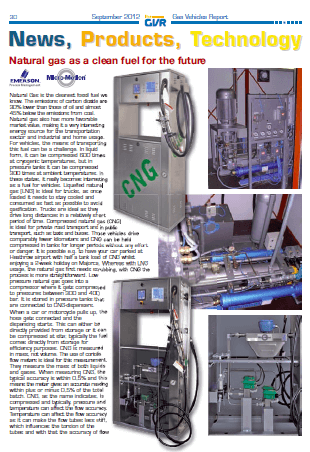 Natural gas has been used as a transportation fuel for many years in world areas such as Europe. With the differential in energy costs between natural gas and refined hydrocarbons, it’s being piloted and considered for use in other world areas such as North America. A Gas Vehicles Report article, Natural gas as a clean fuel for the future (p. 30), describes some of the challenges in and technologies required for its use as a transportation fuel.
Natural gas has been used as a transportation fuel for many years in world areas such as Europe. With the differential in energy costs between natural gas and refined hydrocarbons, it’s being piloted and considered for use in other world areas such as North America. A Gas Vehicles Report article, Natural gas as a clean fuel for the future (p. 30), describes some of the challenges in and technologies required for its use as a transportation fuel.
The article opens noting the emissions advantage of natural gas combustion over oil and coal:
The emissions of carbon dioxide are 30% lower than those of oil and almost 45% below the emissions from coal.
Two common options for using natural gas as a transportation fuel are to compress it by a factor of 600 by cooling to cryogenic temperatures to a liquid state as liquefied natural gas (LNG) or compressing it 300 times as compressed natural gas (CNG). One transportation application for LNG is highlighted:
Liquefied natural gas (LNG) is ideal for trucks, as once loaded it needs to stay cooled and consumed as fast as possible to avoid gasification. Trucks are ideal as they drive long distances in a relatively short period of time.
CNG:
…is ideal for private road transport and in public transport, such as taxis and buses. Those vehicles drive comparably fewer kilometers and CNG can be held compressed in tanks for longer periods without any effort or danger.
In a consumer application, the custody transfer occurs at the gas pump, much as we do today when we fill our cars with gasoline. For CNG, measurement of is based on mass and not volume. The article highlights a mass measurement technology well suited for this application [hyperlink added]:
The use of Coriolis flow meters is ideal for this measurement. They measure the mass of both liquids and gases. When measuring CNG, the typical accuracy is within 0,5% and this means the meter gives an accurate reading within plus or minus 0,5% of the total batch. CNG, as the name indicates, is compressed and typically, pressure and temperature can affect the flow accuracy.
…Coriolis measurement is ideal as it is very sensitive to small and fast flow influences when measured correctly. The design of the flow meter is a vital part of this. It also affects how accurate the measurement is at different flow rates (this is called turndown). The higher the turndown, the more accurate the measurement is over the flow range, from very high to very low. In this way the transaction can be measured fairly.
The article notes a Micro Motion Coriolis meter, the CNG050 that is suitable for this application with the approvals for use in public dispensing applications. It closes noting that this meter has been put to use in over 75,000 installations.




